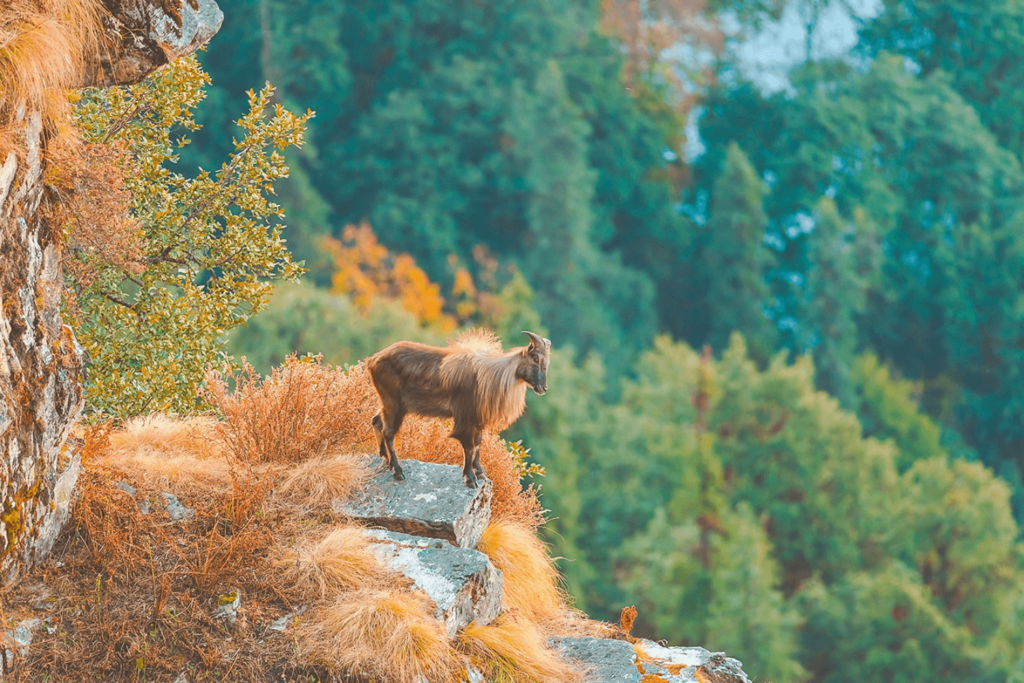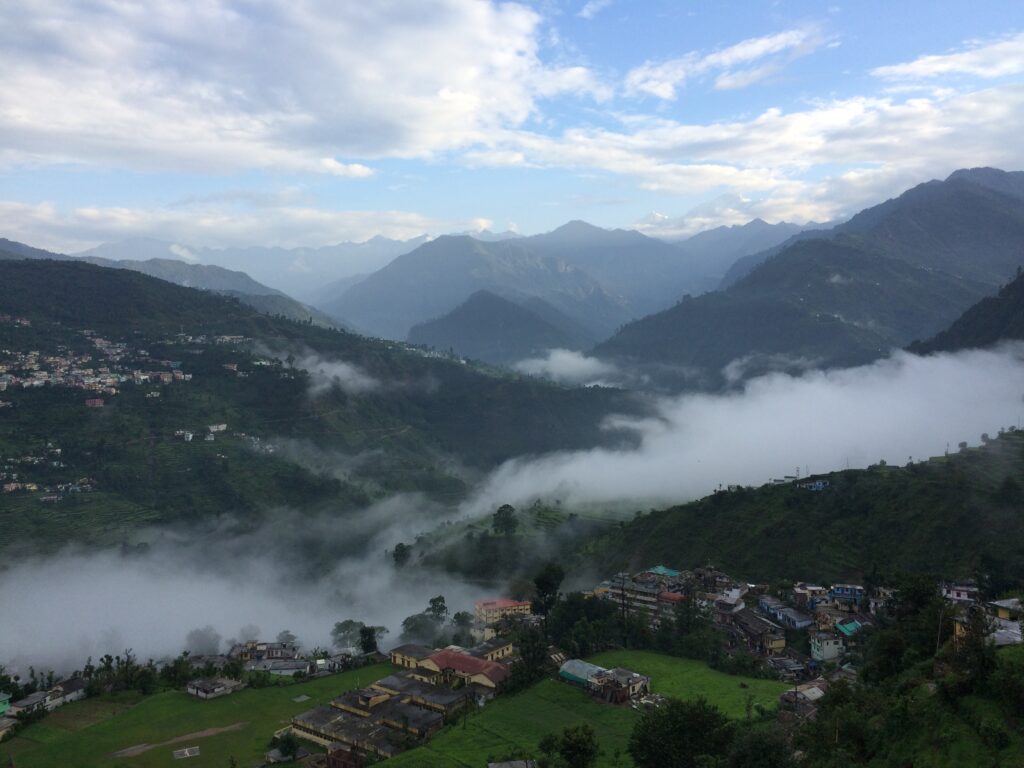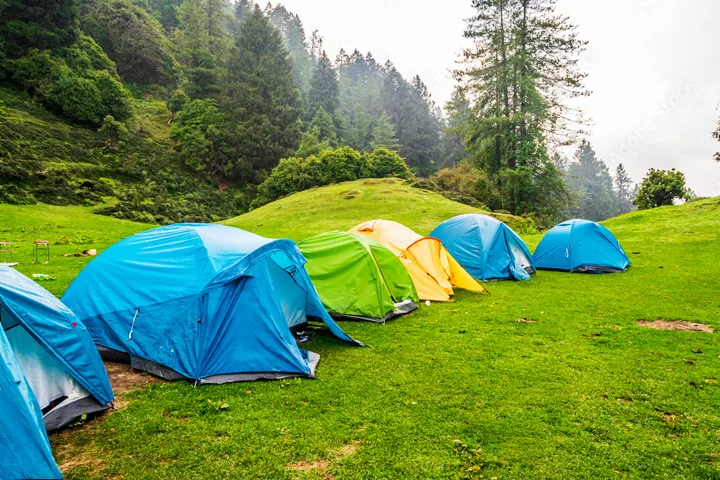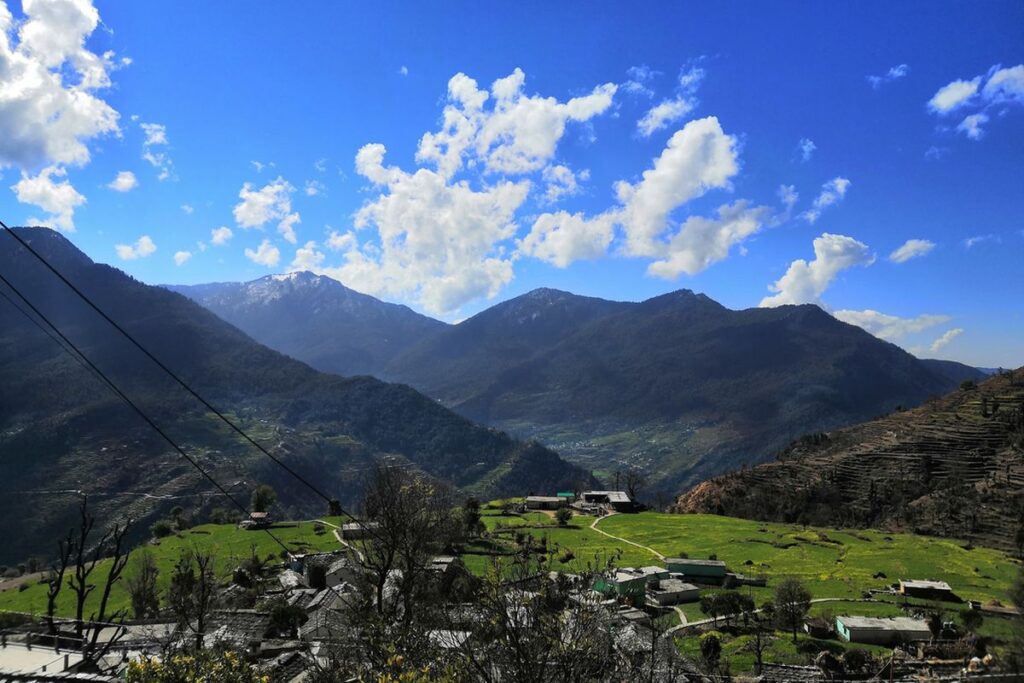Discover the Best Places to Visit in Chopta: A Comprehensive Travel Guide
Chopta, a picturesque spot in Uttarakhand’s Garhwal region, offers a range of stunning locations to explore. Start with the Tungnath Temple, the world’s highest Shiva temple, located at 3,680 meters. The trek to Tungnath is rewarding, leading to breathtaking views of the Himalayas. Just a short hike away is Chandrashila Peak, which provides a panoramic 360-degree view of majestic peaks like Nanda Devi and Trishul.
Deoria Tal is another must-visit, a serene high-altitude lake surrounded by lush greenery, perfect for reflection and relaxation. For wildlife enthusiasts, the Kedarnath Wildlife Sanctuary offers rich biodiversity, including the vibrant Himalayan Monal.
Lastly, Ukhimath, a small town with significant religious importance, serves as the winter abode for the Kedarnath and Madhyamaheshwar deities. These highlights make Chopta a prime destination for nature lovers and adventure seekers.

Best Places to Visit in Chopta: Top 10 Places You Can’t Miss
Chopta, often called the “Mini Switzerland of India,” is a pristine destination nestled in the Garhwal Himalayas of Uttarakhand. Known for its stunning landscapes, lush meadows, and spiritual significance, Chopta offers a plethora of attractions that captivate nature enthusiasts, trekkers, and spiritual seekers alike. Chopta, with its stunning landscapes, spiritual significance, and natural beauty, offers a diverse range of attractions that cater to all types of travelers. From the majestic Tungnath Temple and the panoramic views from Chandrashila Peak to the tranquil beauty of Deoria Tal and the vibrant wildlife in Kedarnath Wildlife Sanctuary, each destination provides a unique experience.
Whether you are an adventure enthusiast, a nature lover, or someone seeking spiritual solace, Chopta has something special to offer. Plan your visit to these top 10 places, and you’ll uncover the true beauty of this Himalayan paradise. In this comprehensive guide, we’ll uncover the top 10 places you can’t miss when visiting Chopta, ensuring you experience the very best of this Himalayan paradise.

1. Tungnath Temple: The Highest Shiva Temple in the World
Perched at an altitude of 3,680 meters (12,073 feet) in the Garhwal Himalayas, the Tungnath Temple is not only a significant religious site but also the highest Shiva temple in the world. This ancient shrine, dedicated to Lord Shiva, is a marvel of spiritual devotion and architectural prowess.
The history of Tungnath Temple is deeply intertwined with Hindu mythology and legend. It is believed to be one of the Panch Kedar, the five temples dedicated to Lord Shiva in the Kedarnath region. According to local lore, after the great battle of the Mahabharata, the Pandavas sought Lord Shiva’s blessing for absolution. Shiva, in the form of a bull, fled from them and transformed into various parts scattered across the Himalayas. The head of the bull is said to have emerged at Tungnath, hence the temple’s sacred significance.
The origins of the temple date back to the 9th century when it was believed to have been established by the legendary sage Adi Shankaracharya, a prominent figure in Hindu philosophy. Adi Shankaracharya is credited with revitalizing Hinduism and spreading the teachings of Advaita Vedanta. His establishment of the Tungnath Temple was part of his mission to restore ancient Hindu shrines and revive spiritual practices.
Over the centuries, the Tungnath Temple has withstood the test of time and the harsh climatic conditions of the Himalayas. It has become a revered destination for pilgrims and trekkers alike, attracting those seeking both spiritual enlightenment and a connection with the divine. The temple’s unique location amidst the snow-capped peaks and its rich historical background make it a remarkable testament to India’s spiritual heritage and natural beauty.

2. Chandrashila Peak: A Panoramic Viewpoint
Chandrashila Peak, located at an elevation of 4,000 meters (13,123 feet) in Uttarakhand’s Garhwal Himalayas, is renowned for its breathtaking panoramic views and spiritual significance. The name “Chandrashila” translates to “Moon Rock,” reflecting its celestial beauty and the legends associated with it.
Historically, Chandrashila Peak holds a prominent place in Hindu mythology and ancient texts. According to legend, this peak was the site where the demon Ravana performed intense penance to attain immortality. The story goes that Lord Rama, in his quest to defeat Ravana, was guided to this peak by the sage Vashistha. It is said that Lord Rama performed puja (worship) at Chandrashila, and the place henceforth became sacred.
The spiritual importance of Chandrashila Summit Trek is further accentuated by its proximity to the Tungnath Temple, the highest Shiva temple in the world. The peak is accessible via a trek from Tungnath, making it a part of the revered Panch Kedar circuit. The trekking route to Chandrashila follows ancient paths, leading through lush meadows and dense forests, which add to the spiritual and historical allure of the journey.
The peak also features prominently in the history of Adi Shankaracharya, the 8th-century philosopher and theologian. Legend has it that Shankaracharya meditated at Chandrashila to attain enlightenment and further solidify his teachings on Advaita Vedanta. His spiritual presence and influence contribute to the peak’s revered status among devotees and trekkers.
Today, Chandrashila Peak is celebrated for its stunning 360-degree views of the Himalayas, including peaks such as Nanda Devi, Trishul, and Kedar Dome. It remains a popular destination for both spiritual seekers and adventure enthusiasts, offering a profound connection to India’s rich historical and spiritual heritage.

The peak also features prominently in the history of Adi Shankaracharya, the 8th-century philosopher and theologian. Legend has it that Shankaracharya meditated at Chandrashila to attain enlightenment and further solidify his teachings on Advaita Vedanta. His spiritual presence and influence contribute to the peak’s revered status among devotees and trekkers.
Today, Chandrashila Peak is celebrated for its stunning 360-degree views of the Himalayas, including peaks such as Nanda Devi, Trishul, and Kedar Dome. It remains a popular destination for both spiritual seekers and adventure enthusiasts, offering a profound connection to India’s rich historical and spiritual heritage.
3. Deoria Tal: A Tranquil High-Altitude Lake
Deoria Tal, a serene high-altitude lake nestled at 2,438 meters (7,999 feet) in the Garhwal Himalayas, is a hidden gem renowned for its breathtaking beauty and tranquil ambiance. Located near the small village of Sari, this pristine lake is surrounded by lush meadows and dense forests, offering a picturesque retreat from the hustle and bustle of everyday life.
The lake’s name, “Deoria Tal,” translates to “Lake of the Gods,” reflecting its spiritual significance and ethereal beauty. According to local legends and folklore, Deoria Tal is believed to be a sacred site where the gods and goddesses once descended to take a dip and enjoy the serene environment. This adds a layer of mystique and reverence to the already enchanting surroundings.
Historically, Deoria Tal has been a part of the ancient trade and pilgrimage routes in the region, with travelers and pilgrims stopping by to rest and find solace by its tranquil waters. The lake is accessible via a pleasant 2.5 km trek from Sari Village, making it a popular destination for nature lovers and trekkers.

The trek to Deoria Tal is relatively easy, winding through verdant forests and terraced fields, and offers stunning views of the surrounding Himalayan peaks. The lake itself is famous for its clear, reflective waters, which perfectly mirror the snow-capped mountains and lush green meadows. This creates a mesmerizing visual effect that is particularly striking during sunrise and sunset.
In addition to its natural beauty, Deoria Tal provides an excellent spot for camping, picnicking, and photography. The peaceful environment, coupled with the stunning reflections and panoramic views, makes it a must-visit destination for anyone seeking a serene escape into nature.
4. Kedarnath Wildlife Sanctuary: A Haven for Wildlife Enthusiasts
Kedarnath Wildlife Sanctuary, spanning approximately 975 square kilometers in Uttarakhand’s Garhwal region, is a prime destination for wildlife enthusiasts and nature lovers. Established in 1972, this sanctuary was created to protect and preserve the diverse flora and fauna of the Kedarnath region, which is renowned for its rich biodiversity and stunning natural landscapes.
The history of the sanctuary is deeply connected with the broader conservation efforts in India during the 20th century. The Indian government recognized the ecological significance of the Kedarnath region, which includes high-altitude meadows, dense forests, and rugged terrain. This diverse environment provides a crucial habitat for many species, including some that are endangered or rare.
Historically, the region surrounding Kedarnath has been a site of spiritual and cultural importance, with the Kedarnath Temple being one of the holiest shrines dedicated to Lord Shiva. The sanctuary’s establishment aimed to balance the needs of conservation with the spiritual and cultural practices of the local communities. By protecting the natural habitat, the sanctuary ensures that the area remains pristine and supports both wildlife and pilgrimage activities.

The Kedarnath Wildlife Sanctuary is home to a variety of wildlife species, including the elusive snow leopard, Himalayan tahr, and musk deer. It also boasts a rich avian population, featuring species such as the Himalayan Monal, the state bird of Uttarakhand. The sanctuary’s varied landscapes—from dense forests to alpine meadows—offer diverse habitats for these species.
For visitors, the sanctuary provides a unique opportunity to experience the natural beauty of the Himalayas while observing wildlife in their natural habitat. The region’s scenic trekking routes allow adventurers to explore the sanctuary’s diverse ecosystems, including lush valleys, glacial lakes, and towering peaks.
5. Ukhimath: A Spiritual Retreat
Ukhimath, a small town located at an altitude of 1,310 meters (4,301 feet), holds immense religious significance as the winter abode of the Kedarnath and Madhyamaheshwar deities. This quaint town serves as a vital pilgrimage hub for devotees seeking spiritual solace in the Himalayas.
Historically, Ukhimath has been an important site for Hindu pilgrims for centuries. After the Kedarnath Temple closes during the winter months, the idol of Lord Kedarnath is brought to Ukhimath and enshrined in the Ukhimath Temple, where devotees can continue to offer their prayers. This practice has been followed for generations, making Ukhimath an integral part of the Kedarnath pilgrimage circuit.

The town is also home to the ancient Madhyamaheshwar Temple, dedicated to Lord Shiva. The temple’s history is steeped in mythology and is part of the Panch Kedar circuit, adding to its significance among pilgrims. The temple’s architecture reflects the traditional style of the region, with intricate carvings and beautiful stonework.
Apart from its religious importance, Ukhimath is surrounded by stunning natural beauty. The town is nestled amidst lush green valleys, towering mountains, and pristine rivers, providing a serene environment for visitors. It serves as a starting point for treks to nearby destinations like Madhyamaheshwar, Chopta, and the stunning landscapes of the Kedarnath Wildlife Sanctuary.
The blend of spirituality and natural beauty makes Ukhimath a must-visit destination for anyone exploring the Kedarnath region. Visitors can experience the peaceful ambiance of the town, interact with locals, and witness the vibrant culture and traditions of the Garhwal Himalayas.
6. Baniyakund: A Scenic Meadow for Camping
Baniyakund, a picturesque meadow located in the Garhwal region of Uttarakhand, is a hidden gem for nature enthusiasts and camping aficionados. Nestled at an altitude of approximately 3,300 meters (10,827 feet), Baniyakund is renowned for its stunning natural beauty and serene environment, making it a popular destination for Chopta Trekking Tour Packages and outdoor adventures.
In more recent history, Baniyakund has gained prominence as a favored camping spot and trekking destination. The meadow’s vast expanse of verdant grass, dotted with colorful wildflowers and flanked by towering peaks, offers a perfect setting for camping and outdoor activities. It serves as a base for trekkers exploring the nearby Chopta Tungnath Trek, providing an ideal spot to relax and take in the breathtaking views.
The meadow’s name, “Baniyakund,” is derived from local vernacular, reflecting the region’s cultural and linguistic heritage. “Kund” means pond or lake in the local language, and “Baniya” is a term used for a merchant or trader. This naming hints at the historical significance of the meadow as a resting place for traders and pilgrims, who would have utilized its lush pastures and clear water sources.

.
The natural beauty and historical significance of Baniyakund make it a beloved location for those seeking a peaceful retreat in the Himalayas. Its blend of serene landscapes and cultural heritage ensures that visitors experience both the tranquility of nature and the rich history of the region.
7. Sari Village: Gateway to Deoria Tal
Sari Village, a charming settlement in Uttarakhand’s Rudraprayag district, is renowned as the gateway to the enchanting Deoria Tal. This picturesque village, situated at an altitude of about 1,950 meters (6,398 feet), serves as the starting point for the trek to the serene Deoria Tal lake, a beloved destination for nature enthusiasts and trekkers, making it an integral part of many Chopta Tour Package.
Historically, Sari Village has been a vital part of the region’s cultural and spiritual landscape. The village is nestled in the lower foothills of the Garhwal Himalayas, surrounded by lush green meadows and dense forests. Its strategic location has made it a crucial stopover for travelers and pilgrims journeying to the higher altitudes of the Himalayas.

Sari Village’s significance is deeply intertwined with the local folklore and religious traditions associated with Deoria Tal. According to local legends, the lake is considered a sacred site where deities are believed to descend. This makes Sari Village not only a practical starting point for the trek but also a place of spiritual importance. The village has historically hosted pilgrims and trekkers, providing them with accommodation and guiding services for their journey to the lake.
The trek from Sari Village to Deoria Tal is a relatively easy hike, offering stunning views of the surrounding Himalayan peaks and diverse flora. The route winds through enchanting forests and open meadows, enhancing the trekking experience. The village itself is known for its warm hospitality and traditional charm, reflecting the rich cultural heritage of the region.
In recent years, Sari Village has gained popularity as an eco-tourism destination, attracting visitors who seek both adventure and tranquility. Its role as the gateway to Deoria Tal ensures that it remains an integral part of the journey to one of the most beautiful and serene lakes in the Himalayas, featured prominently in Chopta Trekking Packages from Delhi.
8. Tugnath Meadows: A Scenic Delight
Tugnath Meadows, situated in the Garhwal region of Uttarakhand, offer a breathtaking blend of natural beauty and historical significance. Nestled at an elevation of around 3,600 meters (11,800 feet), these meadows are part of the larger Tungnath area, which is renowned for its lush landscapes and panoramic vistas.
Historically, Tugnath Meadows have been an essential part of the pilgrimage route to the Tungnath Temple, one of the Panch Kedar temples dedicated to Lord Shiva. The area’s significance dates back to ancient times when it was a vital stop for devotees journeying to the temple, which is the highest Shiva shrine in the world. The meadows provided a much-needed respite for pilgrims and traders traveling through the rugged Himalayan terrain.
The meadows are situated in an area that has long been known for its natural beauty and spiritual importance. Local legends and historical accounts highlight that these high-altitude pastures have been frequented by sages and devotees who sought solace and spiritual enlightenment amidst the serene surroundings. The lush green meadows, dotted with vibrant wildflowers, have served as a tranquil backdrop for meditation and reflection.

In addition to their spiritual and historical significance, Tugnath Meadows are a popular destination for trekkers and nature enthusiasts. The meadows offer stunning views of the surrounding Himalayan peaks, including Nanda Devi and Kedar Dome. The scenic beauty, combined with the historical and spiritual allure of the area, makes Tugnath Meadows a favored spot for those seeking both adventure and tranquility in Adventure Tours in Chopta.
Today, Tugnath Meadows continue to attract visitors with their enchanting landscapes and rich cultural heritage. They remain a testament to the timeless allure of the Himalayas and the enduring significance of the ancient pilgrimage routes.
9. Makka Bhavan: A Hidden Gem
Makka Bhavan, nestled in the serene landscapes of Uttarakhand, is a lesser-known yet historically significant site that offers a unique glimpse into the region’s cultural and spiritual heritage. Located at a moderate elevation, this charming location has become a hidden gem for those seeking tranquility and a connection with nature.
Historically, Makka Bhavan has been an important yet understated part of the pilgrimage route to the sacred Kedarnath Temple. The area is believed to have been frequented by ancient sages and devotees who used it as a resting place during their arduous journeys through the rugged terrain of the Himalayas. The name “Makka Bhavan” is derived from the local dialect, reflecting the area’s deep-rooted cultural and historical significance.

The site gained prominence in the 20th century as efforts were made to preserve and highlight its historical value. The discovery and documentation of Makka Bhavan’s significance were part of broader initiatives to recognize and protect lesser-known historical sites in the region. This has led to a growing interest in Makka Bhavan among travelers and historians who are keen to explore its rich heritage.
In addition to its historical importance, Makka Bhavan offers visitors a tranquil environment, surrounded by lush meadows and picturesque views of the surrounding mountains. The site has become a favored spot for those seeking a peaceful retreat away from the more frequented tourist destinations. The natural beauty and serene atmosphere of Makka Bhavan provide an ideal setting for meditation, relaxation, and reflection during one’s visit to Chopta Camping Packages.
Today, Makka Bhavan remains a hidden gem, appreciated for its historical significance and natural charm. It stands as a testament to the rich tapestry of cultural and spiritual history that defines the Himalayan region.
10. Chopta Village: Experience Local Culture
Chopta Village, often referred to as the “Mini Switzerland of India,” is a picturesque settlement located in Uttarakhand’s Garhwal region. Nestled at an elevation of around 2,680 meters (8,790 feet), Chopta Village offers visitors a unique opportunity to experience the rich local culture and traditional lifestyle of the Himalayan region.
Historically, Chopta has been a crucial stop on the pilgrimage route to the sacred Tungnath Temple, part of the Panch Kedar circuit dedicated to Lord Shiva. The village has long served as a base for pilgrims and trekkers, providing essential services and a glimpse into the traditional life of the region. This historical significance has deeply influenced the cultural practices and lifestyle of the local inhabitants.
The local culture of Chopta Village is characterized by its vibrant traditions and community-centric lifestyle. The village is home to the Rai and Tharu communities, whose customs, festivals, and daily routines reflect a harmonious blend of nature and spirituality. Traditional wooden houses, terraced fields, and local handicrafts showcase the villagers’ deep connection to their environment and heritage.

Visitors to Chopta Village can immerse themselves in local customs by participating in traditional festivals and rituals. Events such as Magh Mela and Baisakhi are celebrated with much enthusiasm, offering a colorful insight into the region’s cultural fabric. Local cuisine, including dishes like Aloo Keema and Kadhi Chawal, provides a taste of the region’s culinary traditions.
Moreover, the scenic beauty of Chopta enhances the cultural experience, with breathtaking views of the surrounding Himalayan peaks and lush meadows. The village’s serene environment and warm hospitality make it an inviting destination for those interested in exploring and experiencing the authentic charm of Himalayan life.
In essence, Chopta Village offers a rich tapestry of local culture, history, and natural beauty, making it a memorable destination for travelers seeking an immersive cultural experience in the heart of the Himalayas, particularly for those considering Group Char Dham Yatra Tours.
Conclusion
Chopta, often hailed as the “Mini Switzerland of India,” is a captivating destination brimming with natural beauty and spiritual allure. From the sacred heights of Tungnath Temple Trek—the highest Shiva temple in the world—to the serene Deoria Tal lake, Chopta offers a diverse array of attractions that cater to both spiritual seekers and nature enthusiasts. The lush meadows of Tugnath Meadows and the picturesque Sari Village further enhance the region’s charm, providing stunning landscapes and a gateway to serene adventures.
Whether you seek adventure through Adventure Trekking in Uttarakhand or the spiritual journey of the Chopta Uttarakhand, Chopta provides a unique and enriching experience. As you explore this stunning landscape, you’ll be captivated by its rich history, vibrant local culture, and breathtaking natural beauty.
With its strategic location and historical significance, Chopta remains a vital part of the Himalayan trekking circuit. Whether you’re planning to visit for a serene getaway, a spiritual pilgrimage, or an adventurous trekking expedition, Chopta offers something for everyone.
Embark on your journey to Chopta, where nature meets spirituality, and create memories that will last a lifetime.

